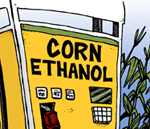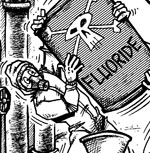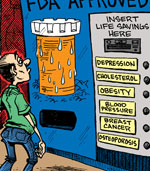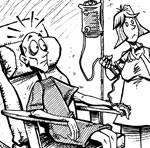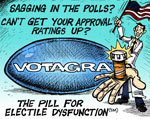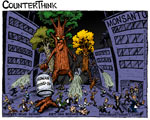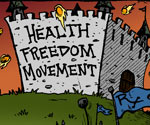Beta Glucans - What You Need to Know to Choose the Right Product for Your Health Goals
| Share on Facebook | Share on Twitter | Share on Google+ |
About 10 years ago I was working for a nutritional supplements company as the junior formulator. At that time, oat beta glucan was a very new ingredient, and our company would have been among the first to offer it commercially.
Where we got stuck in the process of conceptualizing a new product was figuring out why this very useful product would be more useful than, say, eating a hot bowl of oatmeal every day. Then we learned that there were many different kinds of beta-glucans than just the beta-glucans in oats, and that different beta-glucans have very different health effects.
What Is Beta Glucan?
A glucan is a molecule consisting of glucose sugar molecules joined into various geometric configurations. Different glucans have different shapes that allow them latch on to cells in the same way as cholesterol or disease-causing microorganisms, without the ill effects of cholesterol or infection.
The Beta-Glucan Story
Beta-glucans have been used in treating various health conditions since the 1940's. The first beta-glucan product was derived from yeast by Dr. Louis Pillemer, a researcher at Case Western Reserve University in Ohio. Dr. Pillemer discovered that killing yeast and then injecting it into the bloodstream stimulated the immune system in much the same way as live yeast, but without the risk of yeast infections.
Dr. Pillemer called his early beta-glucan product Zymosan. It works through increasing inflammation, especially in the liver, stimulating white blood cells to surround and destroy yeasts and bacteria. The problem with Zymosan was that it could stimulate too much inflammation in the process of fighting an infection.
Dr. Pillemer died in 1957. In the 1960's, Dr. Nicholas DiLuzio at Tulane University in New Orleans found that the immunostimulant ingredient in Zymosan was a complex carbohydrate called 1.6-beta-glucan. After DiLuzio purified 1.6-beta-glucan, Dr. Peter W. Mansell tried injecting the product into skin cancer tumors in human patients. He reported that the tumors began to shrink in just five days, and that smaller skin tumors could be completely destroyed by this form of immune stimulation.
Then, in the 1980's, Dr. Joyce Czop of Harvard University learned how beta-glucan stimulates the immune system. It attaches itself to specific receptor sites on macrophages. Their name literally meaning "big eaters," macrophages are white blood cells engaged in what scientists call "non-specific immune defense." They basically eat everything in their range that is diseased or defective or alien to the human body, and they secrete chemicals that stimulate the regrowth of healthy, normal tissues.
After this discovery, oncologist Dr. Myra Patchen, also at Tulane, confirmed that beta-glucan could regenerate radiation-damaged tissues in mice. This led to tests of beta-glucan injections into the tumors of women treated with surgery and radiation for breast cancer. Dr. Phil Wyde at Baylor Medical Center in Houston, Texas, found that the product did not have to be injected. It could be taken as a pill. And then Dr. Donald Carrow led clinical trials of beta-glucan as a treatment for breast and skin cancer, with significant success.
Where the Science of Beta-Glucan Is Now
That's about the time I became aware of beta-glucan, myself. I had flown out to southern California to attend a National Nutritional Foods Association meeting. (This group now calls itself the Natural Products Association.) My client for whom I developed nutritional supplements introduced me to the manufacturers of 1.6-beta-glucan and gave me stacks of research literature to read on the plane.
I was very enthusiastic about making products with 1.4-beta-glucan. Unfortunately, that is not what we were being sold. And that illustrates a very important point about beta-glucan. The 1.6-beta-glucan that is derived from yeast and mushrooms stimulates the immune system. The 1.4-beta-glucan from oats and barley doesn't. My client was not at all pleased to have this explained to him.
How Can You Use Beta-Glucan?
The most important use of beta-glucan is as an anti-cancer supplement. It is not used to treat cancer. It is used to prevent cancer.
Just about everybody gets cancer. My college physiology professor, Dr. James Wilson, used to teach that about 40% of the population has one or more forms of cancer at any given time, and that most people have cancerous development about six times a year. So how does anyone survive?
Most of the time, our immune systems detect and destroy cancer before it can form tumors or spread, in the very earliest stages of development. "Baby" cancer cells are coated with a protein that has an intensely negative electrical charge. The negative charge on the cancer cell helps it attract positively charged amino acids. It also makes it easier for the cancer cell to receive sugar from the bloodstream and protects it from many kinds of chemicals that the immune system can produce to destroy it.
The pancreas makes an enzyme called chymotrypsin that can eat away at this protective protein coat so that the cancer cell can't absorb as many nutrients. But if your pancreas is damaged by pancreatitis or diabetes, it can't generate as much chymotrypsin. More cancer cells survive long enough to form tumors.
Beta-glucan helps the immune system deal with cancer a different way. When you consume beta-glucan, it survives digestion in the stomach and winds up at the wall of the intestines where white blood cells are on patrol to prevent bacteria from entering the body from food. Tiny particles of beta-glucan activate the macrophages, but since they are not actual microorganisms, the macrophage does not get "stuck in place" removing them. The activate macrophage leaves the intestine and goes back into circulation in the rest of the body better able to detect cancer and bacterial infection.
It's important to know that not just any kind of beta-glucan will stimulated the macrophages so that they can detect and destroy cancer. It has to be a 1.6-beta-glucan, the kind that is found in mushrooms and yeast. If it is a 1.4-beta-glucan, like those found in barley and oats, it won't stimulate the immune system because the molecule does not fit in the "groove" on the white blood cell that stimulates it.
And the product has to be micronized, so that it forms tiny particles that will not clump back together. A "clump" of beta-glucan fiber in the gut is too large to be detected by macrophages as a potential invader. If the product is not micronized, it won't work. It's not hard to find products that work, but not everything that is accurately labeled "beta-glucan" will help fight cancer.
Choosing the Right Immunostimulant Product
Cancer, of course, is not the only condition that benefits from immune modulation. Herpes benefits from a healthy immune system, too. It is important to understand that a healthy immune system is not necessarily a "stimulated" immune system.
In herpes, the virus that causes the disease "hibernates" until the immune system wakes it up. You want your immune system to be "locked and loaded" so it can fight the herpesvirus infection if it is reactivated, but you don't want your immune system to be "shooting" until it does.
Some products like IP6, Cell Forte, and MGN-3 tell the immune system to "Fire!" That's useful if you have an active viral infection, or if you have have an active cancer (although you should always discuss your use of any nutritional supplement with your health care provider).
Other products like beta-glucan stimulate the "patrol" function of the immune system without triggering the "defense" function. In a condition like herpes or HIV, you want your immune system to be able to detect it should it be reactivated, but you don't want the virus to multiply wildly because the tissue in which it is hibernating has been attacked. Beta-glucan keeps the immune system vigilant without being hypersensitive. And it also helps the immune sensitive avoid "over-reaction" that causes allergies.
What About Beta-Glucan for High Cholesterol?
The kind of beta-glucan that helps lower cholesterol is 1.4-beta-glucan. This kind of beta-glucan is found in oats and barley. It lowers cholesterol, but it does not stimulate the immune system.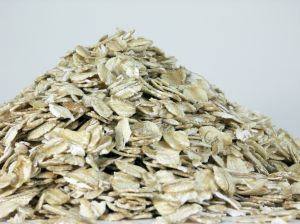
The science of 1.4-beta-glucan for lowering cholesterol is sufficiently well-established that the US Food and Drug Administration allows companies to make claims without seeking prior approval. (That is, if you want to sell a 1.4-beta-glucan product for lowering cholesterol, you don't have to submit scientific studies to the FDA for their review. Actually, there are ways around that requirement, but that's the topic of another article.) The people who are likely to benefit most from taking beta-glucans derived from oats or barley are people who suffer a condition called low high-density lipoprotein syndrome and diabetics.
Low high-density lipoprotein syndrome may cause you (as it did me) to do a double-take, but it's essentially just low HDL cholesterol levels. Statin drugs are useful for treating high LDL, but beta-glucan is probably more useful for treating low HDL. (If you would like to discuss the real benefits of statin drugs, please leave a comment or a question in the Comments Box.)
Diabetics benefit from beta-glucans in several ways. Drs. Jiezhong Chen and Kenneth Raymond of the Australian National University have explained how beta-glucans:
- Lower blood sugar levels
- Reduce hunger caused by falling blood sugar levels
- Slow the digestion of food so that blood sugars do not "spike" as severely after eating
- Lower total cholesterol and LDL cholesterol (but not triglycerides)
- Lower blood pressure
- Help the heart muscle deal with lower oxygen levels
- Accelerate wound healing
But if you are a type 2 diabetic, should not go out and buy a box of oatmeal cookies to get these benefits of 1.4-beta-glucan. You should take at least 3 grams of an oat or barley beta-glucan supplement every day.
Beta-Glucan Benefits from Beta-Glucan Foods?
Since beta-glucans are found in food, it is possible to get the benefits of beta-glucans by eating the foods from which they are derived. If your objective is to stimulate your immune system's ability to monitor cancer and viral infections, then about 100 grams of reishi, shiitake, or maitake mushrooms every day will give you about the same benefit as taking a supplement. Personally, I enjoy these mushrooms as an occasional treat, but it's a lot less expensive to take the supplement.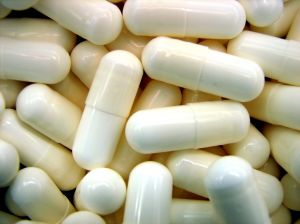
If your objective is to lower cholesterol, then you can do the job with about 100 grams of oat bran a day. That's a very large bowl of oat bran-not oatmeal. You should not eat this much fiber if you don't eat fiber-rich foods on a regular basis. It is necessary to build up to this level of fiber consumption gradually to avoid bloating, constipation, and gas. But it really is easier to take at least 3 grams of oat- or barley-derived beta-glucan supplement every day to raise HDL and lower LDL.
What About Beta-Glucan Side Effects?
The US Food and Drug Administration includes all of the forms of beta-glucan in the Generally Recognized as Safe (GRAS) list. It is pre-approved for use as an ingredient in supplements. Side effects are very rare, but usually related to bloating in people who have gallbladder problems or constipation before they start the supplement.
Where to Buy Beta-Glucan?
Beta-glucan products are available online and in health products stores. Be sure to take beta-glucans from oat or barley for high cholesterol and beta-glucans from mushrooms or yeasts for immune defense.
What About Beta-Glucans for Lipoma?
Lipomas are a very common form of non-cancerous tumor. They often grow under the skin, and they are usually soft to the touch and painless. Lipomas under the skin are a cosmetic issue, although lipomas inside the kidney and liver can be a serious threat to health.
Some online support groups encourage people who have lipomas to use beta-glucan supplements. I think this is basically a good idea if there is some reason you can't just have the lipoma removed and if you know the tumor is not cancerous.
For lipomas, you use the less expensive kind of beta-glucan used to lower cholesterol (made from oats) rather than the more expensive kind of beta-glucan used to stimulate the immune system (made from mushrooms or yeast). What you are trying to do is to stop fat deposits, rather than to stimulate the immune system to attack the tumor.
In fact, stimulating the immune system to attack this kind of tumor could backfire. That is because macrophages (the white blood cells stimulated by the other kind of beta-glucan) tend to get stuck in fatty tissue and cause inflammation and swelling.
The cheap kind of beta-glucan is best for lipomas. Results are not likely to be dramatic, but some users report shrinkage of the tumors in 3 to 4 weeks.
Selected References:
Anderson JW, Story L, Sieling B, et al. Hypocholesterolemic effect of oat-bran or bean intake for hypercholesterolemic men. Am J Clin Nutr. 1984; 40(6): 1146-1155.
Anderson JW, Tietyen-Clark J. Dietary fiber: hyperlipidemia, hypertension and coronary heart disease. Am J Gastroenterol. 1986; 81(10): 907-919.
Behall KM, Scholfield DJ, Hallfrisch J. Diets containing barley significantly reduce lipids in mildly hypercholesterolemic men and women. Am J Clin Nutr. 2004; 80(5): 1185-1193.
Behall KM, Scholfield DJ, Hallfrisch J. Lipids significantly reduced by diets containing barley in moderately hypercholesterolemic men. J Am Coll Nutr. 2004; 23(1): 55-62. Behall KM, Scholfield DJ, Hallfrisch J. Whole-grain diets reduce blood pressure in mildly hypercholesterolemic men and women. J Am Diet Assoc. 2006; 106(9): 1445-1449.
Biorklund M, van Rees A, Mensink RP, Onning G. Changes in serum lipids and postprandial glucose and insulin concentrations after consumption of beverages with ?-glucans from oats or barley: a randomized dose-controlled trial. Eur J Clin Nutr. 2005; 59(11): 1272-1281.
Brown L, Rosner B, Willett WW, Sacks FM. Cholesterol-lowering effects of dietary fiber: a meta-analysis. Am J Clin Nutr. 1999; 69(1): 30-42.
Dersimonian R, Laird N. Meta-analysis in clinical trials. Control Clin Trials. 1986; 7(3): 177-188.
Duval S, Tweedie R. Trim and fill: a simple funnel-plot-based method of testing and adjusting for publication bias in meta-analysis. Biometrics. 2000; 56(2): 455-463.
Follmann D, Elliott P, Suh I, Cutler J. Variance imputation for overviews of clinical trials with continuous response. J Clin Epidemiol. 1992; 45(7): 769-773.
Food and Drug Administration. Food labeling: health claims; soluble fibre from whole oats and risk of coronary heart disease. Fed Regist [online]1997; 62: 15343-15344. http: //www. cfsan. fda. gov/~Ird/fr90331. html. Accessed 15 June 2011.
Gold KV, Davidson DM. Oat bran as a cholesterol-reducing dietary adjunct in a young, healthy population. West J Med. 1988; 148(3): 299-302.
Grundy SM, Cleeman JI, Merz CN, et al. Implications of recent clinical trials for the National Cholesterol Education Program Adult Treatment Panel III guidelines. Circulation. 2004; 110(6): 227-239.
Ikegami S, Tomita M, Honda S, et al. Effect of boiled barley-rice-feeding in hypercholesterolemic and normolipemic subjects. Plant Foods Hum Nutr. 1996; 49(4): 317-328.
Keenan JM, Goulson M, Shamliyan T, et al. The effects of concentrated barley ?-glucan on blood lipids in a population of hypercholesterolaemic men and women. Br J Nutr. 2007; 97(6): 1162-1168.
Keogh GF, Cooper G, Mulvey TB, et al. Randomized controlled crossover study of the effect of a highly ?-glucan-enriched barley on cardiovascular disease risk factors in mildly hypercholesterolemic men. Am J Clin Nutr. 2003; 78(4): 711-718.
Kim SY, Song HJ, Lee YY, et al. Biomedical issues of dietary fiber ?-glucan. J Korean Med Sci. 2006; 21(5): 781-789.
Kritchevsky D. Dietary fiber and lipid metabolism. Int J Obes. 1987; 11(Suppl. 1): S33-S43.
Li J, Kaneko T, Qin L, Wang J, Wang Y. Effects of barley intake on glucose tolerance, lipid metabolism, and bowel function in women. Nutrition. 2003; 19(11): 926-929. Lia A, Hallmans G, Sandberg AS, et al. Oat beta-glucan increases bile acid excretion and a fiber-rich barley fraction increases cholesterol excretion in ileostomy subjects. Am J Clin Nutr. 1995; 62(6): 1245-1251.
Lupton JR, Robinson MC, Morin JL. Cholesterol-lowering effect of barley bran flour and oil. J Am Diet Assoc. 1994; 94(1): 65-70.
Mantel N, Haenszel W. Statistical aspects of the analysis of data from retrospective studies of disease. J Natl Cancer Inst. 1959; 22(4): 719-748.
Marlett JA. Sites and mechanism for the hypocholesterolemic actions of soluble dietary fiber sources. Adv Exp Med Biol. 1997; 427: 109-121.
McIntosh GH, Whyte J, McArthur R, Nestel PJ. Barley and wheat foods: influence on plasma cholesterol concentrations in hypercholesterolelmic men. Am J Clin Nutr. 1991; 53(5): 1205-1209.
Narain JP, Shukla K, Bijlani RL, et al. Metabolic responses to a four-week barley supplement. Int J Food Sci Nutr. 1992; 43(1): 41-46.
National Cholesterol Education Program (NCEP). Third Report of the NCEP Expert Panel on Detection, Evaluation and Treatment of High Blood Cholesterol in Adults (Adult Treatment Panel III). National Heart Lung and Blood Institute; 2002: 1-284.
Newman RK, Lewis SE, Newman CW, Boik RJ. Hypocholesterolemic effect of barley foods on healthy man. Nutr Rep Int. 1989; 39: 749-760.
Oscarsson M, Andersson R, Aman P, et al. Effects of cultivar, nitrogen fertilization rate and environment on yield and grain quality of barley. J Sci Food Agric. 1998; 78: 359-366.
Pick M, Hawrysh Z, Gee M, Toth E. Barley bread products improve glycemic control of Type 2 subjects. Int J Food Sci Nutr. 1998; 49(1): 71-78.
Prentice N, Qureshi AA, Burger WC, Elson CE. Response of hepatic cholesterol, fatty acid synthesis and activities of related enzymes to rolled barley and oats in chickens. Nutr Rep Int. 1982; 26(4): 597-604.
Qureshi AA, Burger WC, Elson CE, Benevenga NJ. Effects of cereals and culture filtrate of Trichoderma viride on lipid metabolism of swine. Lipids. 1982; 17(12): 924-934.
Schneeman BO. Dietary fiber and gastrointestinal function. Nutr Res. 1998; 18(4): 625-632.
Shimizu C, Kihara M, Aoe S, et al. Effect of high ?-glucan barley on serum cholesterol concentrations and visceral fat area in Japanese men-a randomized, double-blinded, placebo-controlled trial. Plant Foods Hum Nutr. 2008; 63(1): 21-25. Epub 2007 Dec 12.
Talk Paper FDA. FDA allows whole barley foods to make health claim on reducing the risk of heart disease. http: //www. fda. gov/bbs/topics/NEWS/2006/NEW01375. html. Accessed 15 June 2011.
Van Horn LV, Liu K, Parker D, et al. Serum lipid response to oat product intake with a fat-modified diet. J Am Diet Assoc. 1986; 86(6): 759-764.
Wood PJ. Cereal ?-glucans in diet and health. J Cereal Sci. 2007; 46: 230-238.
Zhang J-X, Lundin E, Andersson H, et al. Brewer’s spent grain, serum lipids and fecal sterol excretion in human subjects with ileostomies. J Nutr. 1991; 121(6): 778-784.
-
Skin CareMen Skin Care
-
Free ResourcesFree eBooks
-
You can free yourself from aging by reinterpreting your body and by grasping the link between belief and biology.Deepak Chopra
-
What We RecommendIf you do an analysis of the ingredients in a bottle of
 Total Balance and compare with other products you will find that it provides exceptional value for money…even against simple mass produced products with lower bottle costs.
Total Balance and compare with other products you will find that it provides exceptional value for money…even against simple mass produced products with lower bottle costs.
-
